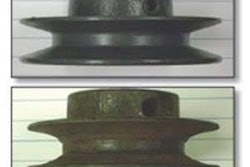Gainco "DataMan" Plant System
Gainco has offered plant system results in real time before, but has now refined its DataMan Data Collection System. This system provides a hub to receive raw information on line speeds or flows or subsystems from others. The upgrade provides the e-mailing capability to send reports on process results or out-of-tolerance conditions to any e-mail address. Radio frequency devices in the plant add even more flexibility to data collection and information management, allowing the use of simple hand-held PDA devices providing each technician or manager access to information, monitor totals, yields and throughput, and to make changes to system settings and parameters.
CAT Squared Manufacturing Execution System
Upgrades to the CAT Squared plant monitoring system include the ability to e-mail (or phone) the feedback from multiple areas like HACCP points and process sensors to supervisors or maintenance. This real-time information system has the software to identify negative trends before they actually hit a critical level. Along with this, if things actually go wrong and are critical, or have been wrong for some time, another level of management is e-mailed or telephoned, showing exactly where to focus to fix the problem.
Morris "Quick Chill 3000" Self-Diagnosing Controller
Morris showed a new touch-screen controller for the whole chilling process which sends an e-mail any time tolerances are out-of-line. They have the display information set up so that as the temperature shifts, or flows change, an e-mail can be sent saying which of the numbers is becoming out-of-tolerance. This can be combined with the ability to control the chillers or unloaders as the line speed changes.
Morris-Bio-Theta 6 Hour Bacteria Sampling (Dox)
Quicker results from testing for bacteria can mean less exposure while waiting for critical data on products we need to ship. This testing method is simpler, more controlled and accurate. It uses simple cartridges that are loaded into containers which feed the information from remote locations to a central computer.
Meyn Shackle Jackal
This touch panel allows processors to monitor shackle condition during production, and to expose ones that need attention. There are thousands of shackles in the process, each too valuable to risk failure. Good operators know the cost of missing just one shackle on every revolution and the paybacks are fast for keeping all of them working correctly.
Wolf-Tec Controlled Injection/Tumbling
Wolf-Tec combined the process of IMAX injecting and POLAR tumbling into a sort of super-controlled, continuous-batch process, which has become a proven method of optimizing marinate usage and yields. The system allows operators to set critical parameters, and to receive e-mails when any part of the process is out-of-tolerance. The logic of deep muscle injection added into the process, with the excellent dispersion ability of their tumblers, is a logical fit for the two-inch-thick fillets of today. By attaching the control points in the system to heavy-duty weighing devices and providing continuous tracking and reporting, these systems can provide 2% yield in processes where we normally struggle for one decimal point in yield.
Meyn Digital Grading System Upgrade
These systems continue to improve, with the Meyn unit combining both front and back cameras. This provides a cleaner image, making it possible to inspect and grade the whole bird at once.
Meyn Emergency Stop Control System
"Which e-stop has just stopped the line and why?" The Meyn safety controller system pinpoints the exact e-stop button so that lines can be started without the typical time-consuming search. With downtime costs of hundreds of dollars per minute, this payback can be huge.
Necessity is said to be the mother of invention and today's tough economic times have certainly put pressure on processors to be as efficient as possible. Fortunately, equipment suppliers were hard at work over the last year developing new technologies to help processors get the most out of every bird. Advances in monitoring and control systems provide a good example of how the latest generation of equipment can help improve efficiency. This report is the first in a series providing a whirlwind tour of efforts of some of the processing exhibitors this year. The intention was to only discuss new devices, modifications or uses since the 2008 IPE.
Providing immediate feedback
Monitoring and control systems for individual pieces of equipment and whole plants are becoming better and more accepted. Nearly all U.S. plants have had some sort of monitoring or control system over the years. These have had varying levels of success; most were minimally effective at best, so their reputation for staying in place has not been very good. Over the past few years, however, things have changed. In particular we now have sensors which will survive in the destructive environment of the plant, automatically remember all the steps and signal us when things are different.
Good information systems have gone from a computer on someone's desk to Blackberrys and I-Phones on the belt of lots of managers. As these systems become "connected" to the correct "process and machine adjustment" people, this becomes valuable. Many plants ship $1 million of product per day, and adjustments can easily be worth over 1%, putting the value at over $10,000 per day just to prevent small problems from becoming catastrophes. The combination of good information and having information sent directly to managers immediately, makes these systems valuable. It just makes sense that if we drive a $40,000 car with gauges right in front of us, we should do the same for a $200 million plant to know what's going on.
We found lots of ways to monitor or control processes automatically. Nearly all companies which provide intricate sub-processes like marination, chilling and portioning have evolved controls which remember all the steps and report the results continuously.

















